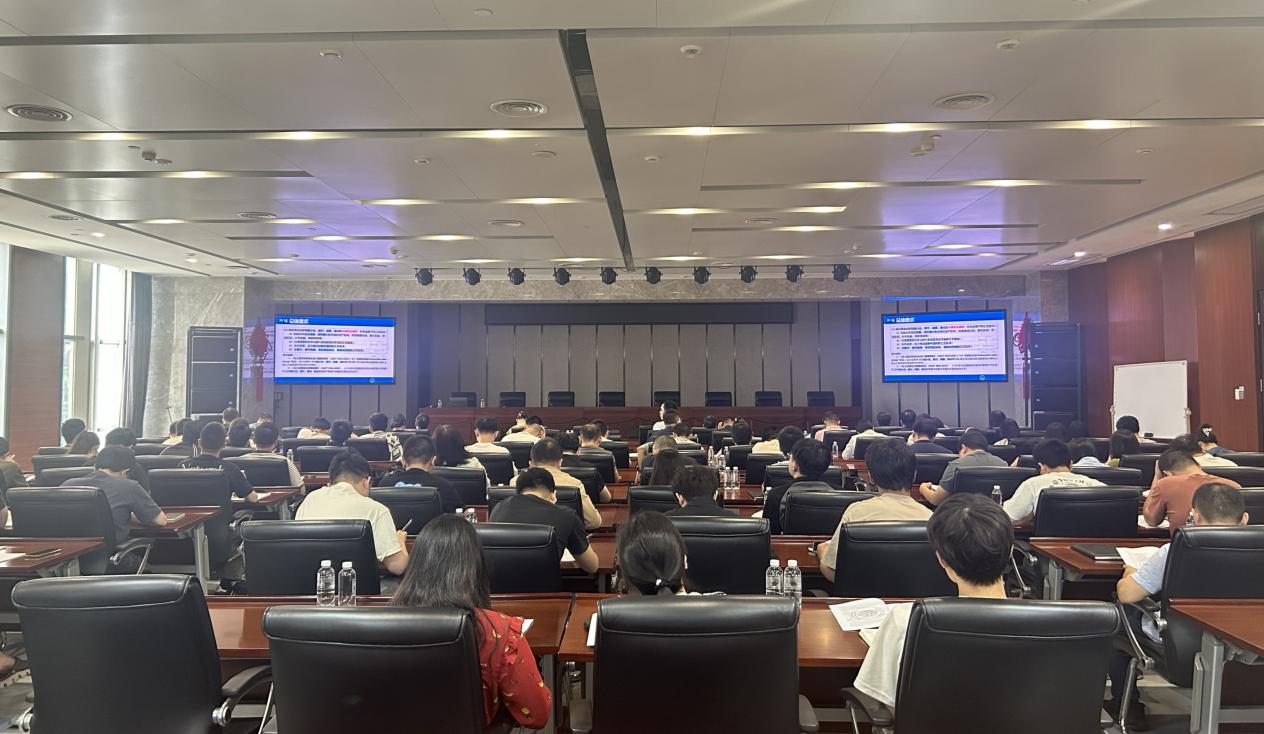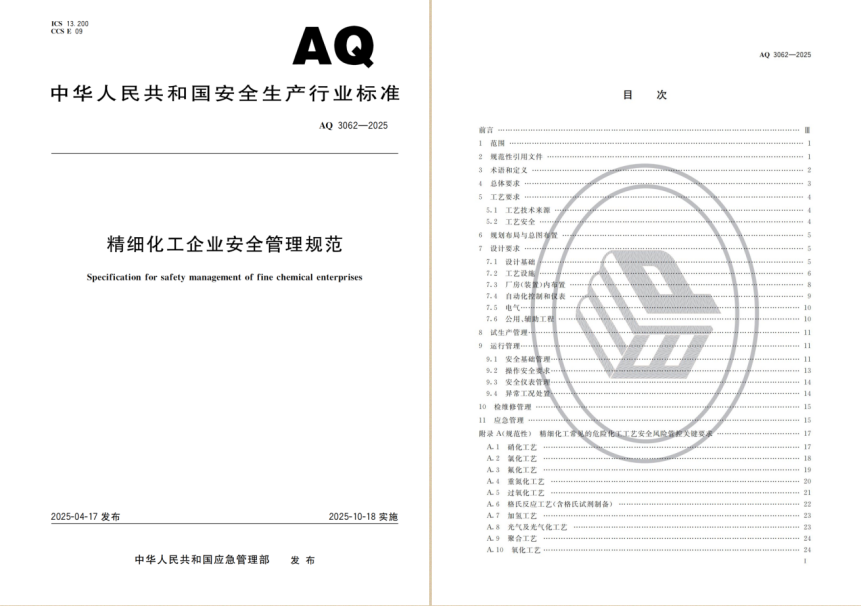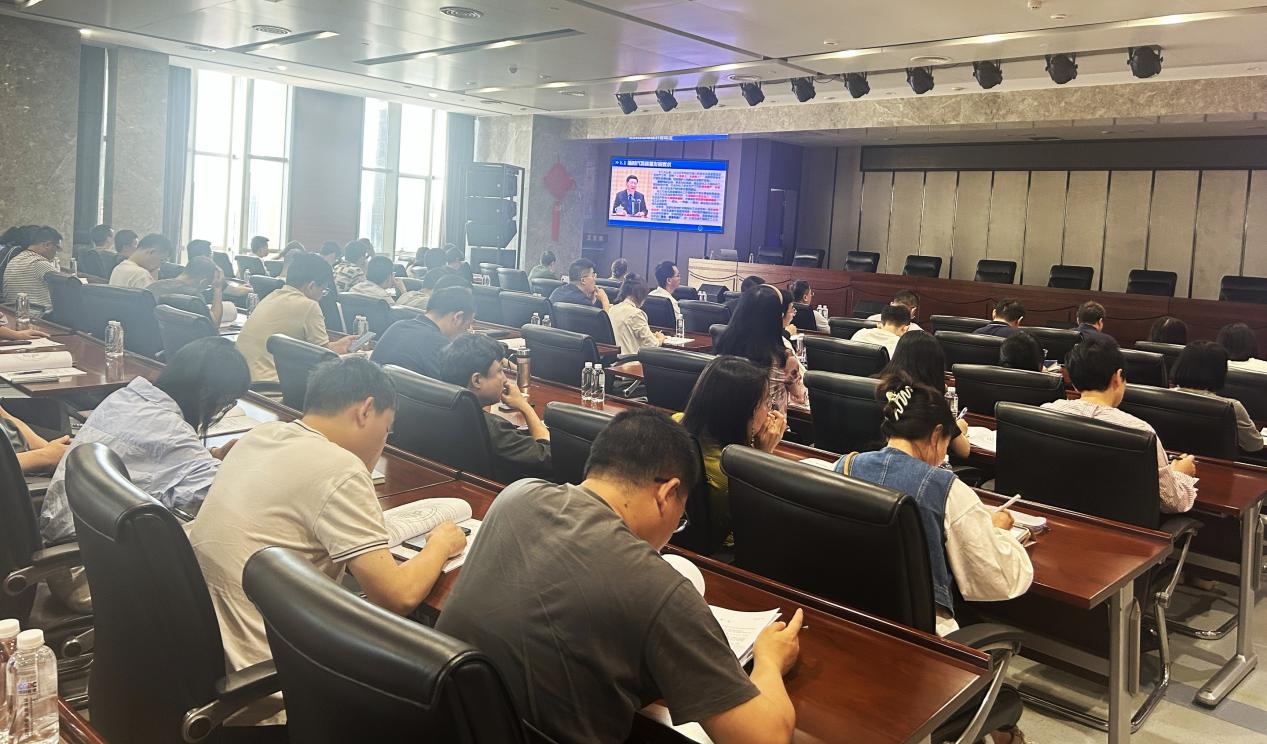
The School of Chemical Engineering organized a centralized video training session on the Ministry of Emergency Management's "Safety Management Standards for Fine Chemical Enterprises"
On May 29, the Ministry of Emergency Management held a video training session on the "Safety Management Regulations for Fine Chemical Enterprises". The Chemical Engineering Institute organized a collective video training session in the academic report hall on the 22nd floor, with more than 80 people attending, including Deputy General Manager Yang Fangwen, heads of various departments, and relevant professionals.
Release time:
2025-05-30 10:32
Source:
Chemical Engineering Branch 1
Responsibility:
Zhou Peng
On May 29, the Ministry of Emergency Management conducted a video training session on the "Safety Management Regulations for Fine Chemical Enterprises". The Chemical Engineering Institute organized a centralized video training session in the academic report hall on the 22nd floor, with over 80 people in attendance, including Deputy General Manager Yang Fangwen, department heads, and relevant professionals.
 The mandatory safety standard "Safety Management Regulations for Fine Chemical Enterprises" (AQ 3062-2025), promulgated and released by the Ministry of Emergency Management, will be implemented on October 18, 2025. The release and implementation of this regulation marks the first release of a national safety management standard for fine chemical enterprises in China. It will help to achieve systematic and standardized safety risk control and will strongly promote fine chemical enterprises to improve their inherent safety level and safety assurance capabilities from the source.
The mandatory safety standard "Safety Management Regulations for Fine Chemical Enterprises" (AQ 3062-2025), promulgated and released by the Ministry of Emergency Management, will be implemented on October 18, 2025. The release and implementation of this regulation marks the first release of a national safety management standard for fine chemical enterprises in China. It will help to achieve systematic and standardized safety risk control and will strongly promote fine chemical enterprises to improve their inherent safety level and safety assurance capabilities from the source.
 There are numerous fine chemical enterprises in China, many of which are small and micro-enterprises. Overall, the level of automated control and inherent safety is relatively low, the professional skills of employees are weak, and the safety assurance capabilities are insufficient. In recent years, more than half of the major and above chemical accidents have occurred in fine chemical enterprises, making them a key focus and difficulty in safety risk prevention and control. The "Safety Management Regulations for Fine Chemical Enterprises" focuses on fundamentally eliminating accident hazards and fundamentally solving problems. Adhering to the principles of problem orientation, practicality, and moderate forward-looking, it addresses weaknesses exposed by typical accidents in fine chemical enterprises in recent years, such as unclear sources of process technology, low design requirements, low level of automation, and incomplete assessment of reaction safety risks, clarifying technical measures and management requirements; at the same time, it summarizes the effective practices of recent special governance of fine chemical safety, expert guidance services in high-risk sub-sectors, and various regions and enterprises, drawing on advanced technological concepts to standardize the technical sources, project design, trial production, and operation management of fine chemical enterprises.
There are numerous fine chemical enterprises in China, many of which are small and micro-enterprises. Overall, the level of automated control and inherent safety is relatively low, the professional skills of employees are weak, and the safety assurance capabilities are insufficient. In recent years, more than half of the major and above chemical accidents have occurred in fine chemical enterprises, making them a key focus and difficulty in safety risk prevention and control. The "Safety Management Regulations for Fine Chemical Enterprises" focuses on fundamentally eliminating accident hazards and fundamentally solving problems. Adhering to the principles of problem orientation, practicality, and moderate forward-looking, it addresses weaknesses exposed by typical accidents in fine chemical enterprises in recent years, such as unclear sources of process technology, low design requirements, low level of automation, and incomplete assessment of reaction safety risks, clarifying technical measures and management requirements; at the same time, it summarizes the effective practices of recent special governance of fine chemical safety, expert guidance services in high-risk sub-sectors, and various regions and enterprises, drawing on advanced technological concepts to standardize the technical sources, project design, trial production, and operation management of fine chemical enterprises.
 The Chemical Engineering Institute has been deeply engaged in the fine chemical industry for over 60 years, always regarding the inherent safety of projects as the lifeline and primary responsibility of design. Proactively, deeply, and systematically studying the latest national safety regulations is the foundation of fulfilling this responsibility. Through this training, the safety risk awareness and prevention capabilities of the Chemical Engineering Institute's technical team have been substantially improved. Next, the Chemical Engineering Institute's technical team will quickly translate the learning outcomes into the specific design principles and review processes of projects, ensuring that every design output strictly complies with the latest national safety standards, providing clients with truly safe, compliant, and reliable engineering design solutions, and effectively shouldering the responsibility of safeguarding inherent safety from the design source.
The Chemical Engineering Institute has been deeply engaged in the fine chemical industry for over 60 years, always regarding the inherent safety of projects as the lifeline and primary responsibility of design. Proactively, deeply, and systematically studying the latest national safety regulations is the foundation of fulfilling this responsibility. Through this training, the safety risk awareness and prevention capabilities of the Chemical Engineering Institute's technical team have been substantially improved. Next, the Chemical Engineering Institute's technical team will quickly translate the learning outcomes into the specific design principles and review processes of projects, ensuring that every design output strictly complies with the latest national safety standards, providing clients with truly safe, compliant, and reliable engineering design solutions, and effectively shouldering the responsibility of safeguarding inherent safety from the design source.
Latest information
 湘公网安备 43011102001763号
湘公网安备 43011102001763号